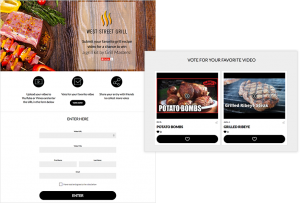Imagine creating a website for a goldfish (or Dory in Finding Nemo.)
In a way, your customers are goldfish.
I mean, they have an attention span compatible to that of Dory.
Most people have an “Internet attention span” of 6 – 8 seconds, while a goldfish has an attention span of 9 seconds.
That’s why it’s so challenging to get your visitors to stick around and read your product sales page.
An evaluation of learning style found that among 221 subjects, 105 were visual learners while only 11 were verbal learners. Plus, the average American adult has a reading level equivalent to that of a grade 8 student, which means if you put too much copy that is too complicated on your website, you’re going to lose the attention of, and therefore sales from your visitors.
What does that all mean?
It means visual content that captures your visitors’ initial attention, and be able to maintain it while communicating the most essential information about your product is going to keep your visitors on your product page longer to consume the content, resulting in more sales and conversion.
Product videos can deliver such experience. Viewing product videos boosts confidence, engagement and purchasing along with subsequent loyalty toward websites.
Customers report that they have more confidence in potential purchases (51 percent) and are less likely to return those products (52 percent) when they view videos of the products. (source)
Unbounce found that explainer videos can help increase conversion rate by 20%.
Here’s an example of an (old) explainer video. This video has increased conversion by 10% – translating into “several thousand” signups for Dropbox per day.
The use of videos to demonstrate products and build trust with consumers has been found to be effective for many different kinds of businesses and retailers to boost sales and conversion:
Product Videos For Fashion
One reason that many consumers are reluctant to purchase clothing and shoes online is that they can’t look at the products from different angles. The use of videos to show merchandize in three-dimension and even on different models can help reduce perceived risk and boost sales.
Zappo has been successfully using video for product demo to great success. It’s found that sales increased by 6% to 30% for items with video demos on the product sales page. (source)
Zappo has been using product videos effective to increase sales and conversion.

In this case study, the use of video on product pages led to a 134% boost in conversions for an online fashion retailer.


Product Videos for Health And Fitness Businesses
Health and fitness is always a big market, and more and more consumers are getting comfortable with purchasing these items online.
However, there’s also a lot of competition and many are wary of unpredictable quality from online retailers.
Including videos in your product page can help you stand out, increase credibility and build trust:

Ski equipment retailer Simply Piste uses videos for product demo on their sales pages, and saw an increase in conversion rate by 25%.
Video demonstrating the details of a backpack.
Product Videos For Household Products
If you’ve been in a department store, you probably have seen salespersons demo-ing kitchen gadgets. This is a very effective way to let shoppers see the product in action and imagine themselves enjoying the product, thereby increasing desire to purchase.
Homewares retailer Stack And Stacks reported that shoppers were 144% more likely to make a purchase after seeing a product video compared to those who didn’t. (source)

A video that shows the product in action, explain how it works, provide dimension and installation instruction helped boost conversion.
Product Videos For Software
It’s much easier for potential customers to understand how a piece of software works by seeing it in action than by reading about it. A quick demo can explain what the software does and showcase the various features better than paragraphs of text.
You can also demonstrate the ease of use by creating something right in front of the eyes of your viewer within a minute or two. This helps viewers overcome the fear that they’re not “tech-ie” enough to use your software.
After adding the video to the website, Rypple saw a 20% increase in conversions. Approximately 30% of the traffic that lands on the page watches the video, and approximately 50% of those viewers watch the video in its entirety.
Product Videos for Coaching & Consulting
Video is not just for product-based businesses. The use of video on David Boozer’s site has increased time spent by visitors on the site. Those who view the videos are also 64% more likely to purchase.
As videos are getting more popular among businesses to showcase their products, it’s no longer good enough to throw a couple of random mp4s onto your website and call it a day.
You need to make sure your videos are created to take advantage of the medium, and provide the necessary information customers need to make a purchasing decision. Here are 5 ways to increase sales and conversion rates using product videos:
Grab your visitors’ attention
Video as a medium is very effective in grabbing attention. According this this article on Forbes, it incorporates 4 psychological elements that we as human beings are wired to pay attention to:
- Face – we are hard wired to look at faces to gather information and assess believability.
- Voice – human voice adds meaning to content
- Emotions – subtle body language appeals to our brain in different ways than verbal information, adding more richness to the communication
- Movement – since our caveman days, we survive by noticing things in motion… so anything that moves naturally captures our attention.
This explains why using models and/or talking heads in your product demo can help your brand connect with your customers.
The model or spokesperson on the video not only needs to deliver convincing content, but they also need to pay attention to how their facial expression, voice, body language and subtle movements contributes to building the “like, know and trust” factor with your potential customers.
Select models and spokespersons that reflect your brand message and brand voice. Use language, terms and slangs your target audience can relate to in the script, and make sure it’s delivered in a relatable manner.
Make your visitors stay longer
The Internet attention span is notoriously short. A study found that the average user stays on a webpage for just 6 seconds!
Once you make the first impression and capture your viewers’ attention in the first few seconds, you need to maintain that attention at the same interval.
A video on your webpage can make those who don’t like to read long sales copy stick around and learn more about your products.
Multimedia files such as videos tend to hold the viewer’s attention for longer, giving you the opportunity to pique their interest enough so they’d stay on your product page and learn more.
To take advantage of the tendency for visitors to pause and check out a video (because we are hard-wired to!), make sure you grab their attention in the first few seconds.
As human beings, we are intrigued by stories. Stories tap into our emotions and make events more memorable.
You can employ various storytelling techniques in your videos to connect with your audience.

“False start” storytelling technique can be used as a quick attention hack to disrupt your audience’s expectations and surprise them into paying closer attention to your message.
Images source: http://www.spakol.com/engage/8-classic-storytelling-techniques-for-engaging-presentations/
Of course you’re not going to share your entire life story, or the whole process of how your team created the product. Just a few snippets that reflect your brand personality and the human element in your products can go a long way to connect with your audience.
Open loop can be a very powerful storytelling tool especially when you need to pique the curiosity of your audience within the first few seconds of the video.
Your videos also need to be benefit-focused, engaging the audience with the outcome they can achieve with your products or services. Your content needs to communicate why your products are relevant to their needs and wants.
Don’t forget to make it fun! A touch of humor and personality can go a long way in making your brand relatable, and sometimes using cartoon illustrations can lighten the tone.
Example of an explainer video using cartoon illustration.
Show, don’t tell – demo your products
It’s very powerful to show your products in action, especially if there’re steps your customers need to follow to set up or operate the item.
Showing potential buyers how to engage with your products can increase conversion rate by removing uncertainty about the item.
Use models or spokespersons that your customers can relate to so they can see how they can engage with your product in their minds.
To create an engaging product demo that converts, pay attention to these best practices:
- Don’t fly by the seat of your pants – prepare and follow a script.
- Have a strong opening – according to Bryan Eisenberg, 80% of the viewers who watch the first 12 seconds of a video will continue to watch it until the 70 seconds mark.
- Keep it short – the ideal length of a product demo video is around 2 minutes.
- Focus on the product and demonstrate how it fits into your viewers’ lives… don’t try to be clever.
- Keep it simple – don’t try to cram everything about the product into a 2-minute video. Highlight 2 or 3 important features and common use cases most relevant to your audience.
- Provide context – show the product in action within a setting your viewers can relate to and put themselves in.
- Include a call-to-action – like all conversion-focused content, you need a clear, compelling and powerful CTA to get viewers to take the next step.
- Make it high quality – this study found that 53 percent surveyed prefer professionally produced videos. Additionally, those videos are perceived as more reliable when making purchase decisions (47 percent).
Answer questions and address objections
Product video is a great place to address common questions your potential buyers may have about your product.
By answering some frequently asked questions in your video, you can address concerns before they arise in the customer’s mind, and turn potential objections into opportunities for providing additional information about your product that will lead to a purchasing decision.
Build trust and authority
People want to buy from those they trust and consider to be authority figures in the market.
There are a few ways to build trust with video:
- Add a human dimension – don’t be too clinical in your product videos. People buy from people, not a logo, so make sure they can relate to your brand. This human dimension can be communicated through the aesthetics, by sharing a story, and having “real people”, such as your team members, to do the demo or bringing in a couple of “behind the scene” snippets.
Zappo has used product videos successfully to increase sales by 6 – 30% using their employees to demo the products.
- Use customer testimonial videos – you can toot your own horn all day, yet good reviews weigh more than anything you say when it comes from customers who have used your products and achieved satisfactory results.
- Use product reviews – a review published by a third party, particularly one considered to be an authoritative source, can help build trust in your brand via impartial means.
- Add interactivity – replicate in-store experience by adding interactive functionality to your product page using videos. Fashion brands are using “catwalk videos” to showcase their products with success. Live Link Video allows merchants to add hyperlinks to their videos, so customers not only watch a video, but also “touch” and purchase the products right through the video.


Fashion brand ASOS has a “view catwalk” function on their product page that opens up an overlay to display a video.
- Talk about your competitors – this may sound counter-intuitive at first but an objective perspective about your competitor’s product from the customers’ point of view can help build authority. Brands that disparage their competitors, or worse, claim that they have no competition, are seen as egotistical and unrealistic, and won’t win the trust of their customers.
Using videos to showcase your product can give you an edge in communicating with our website visitors and increase sales and conversion.
The key is to capture attention, be succinct, put the spotlight on the product and focus on building trust. Of course, don’t forget to track and learn from the results.
Over to you – have you been using product videos on your website? What works, and what doesn’t? Let us know in the comments!
Digital & Social Articles on Business 2 Community
(141)
Report Post





